Meet Playing Preschool: A hands-on homeschool preschool program that works. Playing Preschool gives families a fresh take on doing preschool at home – one that’s rooted in play, built on connection, and designed to be easy to follow. With detailed guidance and thoughtfully sequenced lessons, this program makes homeschooling preschool feel doable, joyful, and effective.
- Who is Playing Preschool for?
- How Playing Preschool Helps Families Thrive
- How Playing Preschool Works
- What a Day with Playing Preschool Looks Like
- A Solid Start to Learning with Built-In Flexibility
- Step-by-Step Support from the Start
- What Your Child Will Learn
- A Note on Year 2 & the Intentional Flow of Playing Preschool
- Why Playing Preschool Works
- Frequently Asked Questions about Playing Preschool
What Are You Teaching Your Child Today?
Who is Playing Preschool for?

Playing Preschool is a homeschool preschool program created for families with children ages 2.5 to 5 to build a strong educational foundation while keeping learning fun, flexible, and rooted in play.
This simple, play-based curriculum is built on a powerful belief: you are your child’s best teacher. It’s designed to support parents because the early years should be joyful, not stressful.
Unlike other programs that pile on prep work or leave you guessing what to teach and when, Playing Preschool removes the mental load with ready-to-go plans and step-by-step guidance. Everything you need is right here, so you can focus on what matters: enjoying this time together.
How Playing Preschool Helps Families Thrive
Playing Preschool is an open-and-go homeschool preschool program that’s big on play and light on prep. It’s grounded in early childhood best practices, built on a strong academic framework, and designed to fit beautifully into the lives of busy families with young children.
No Overthinking Required | Each themed unit comes with clear, thoughtful instructions, so parents know exactly what to do, when to do it, and why it matters.
A Predictable Flow for Kids | Daily lessons follow a gentle rhythm, helping young learners feel secure and excited for what’s next.
All Play, No Worksheets | Because real learning happens through play, this curriculum skips the worksheets and dives into hands-on, developmentally appropriate activities.
Memories Made Together | It’s not just kids who love Playing Preschool – parents do, too. Families often find themselves laughing, connecting, and learning side-by-side.
Preschool at home has never felt this doable – or this fun.
How Playing Preschool Works
What sets Playing Preschool apart is its intentional design. It’s built to fully support parents every step of the way. Whether you’re brand new to homeschooling or have years of experience, this program makes it easy to succeed.
Take a Look Inside
Playing Preschool is thoughtfully structured and easy to follow
That’s five pre-planned lessons each week for 38 weeks, just like traditional school.
Once you purchase, the entire program is delivered instantly as a digital download. You’ll receive:
Unit Introduction
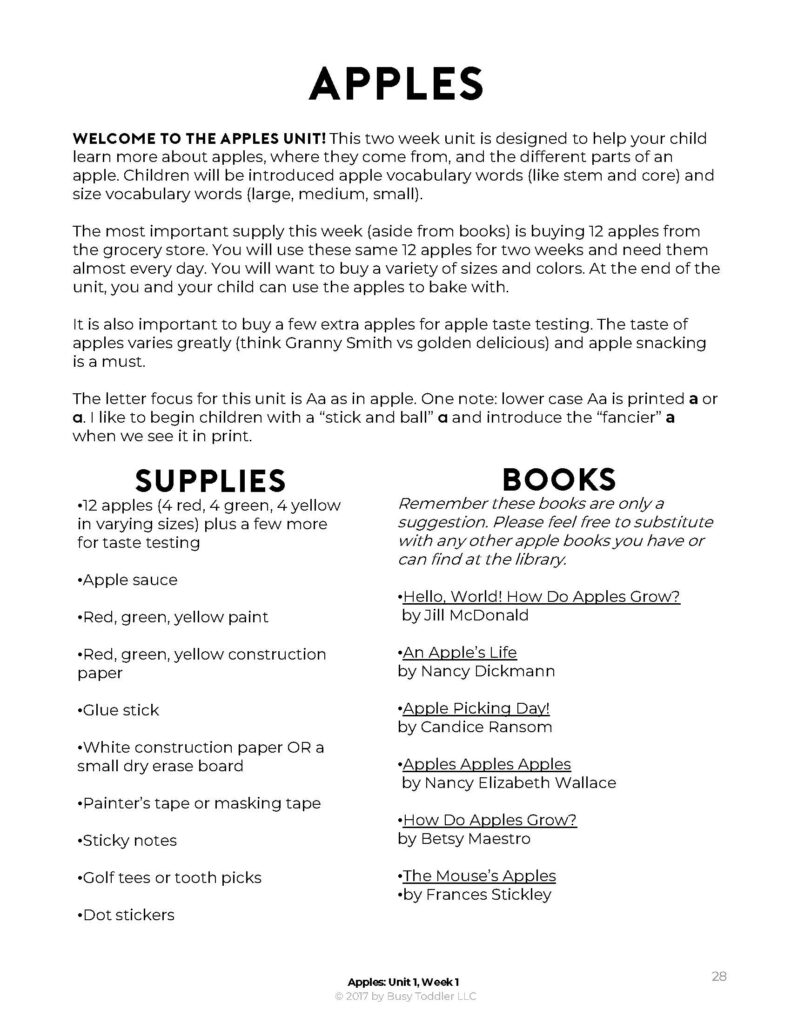
Weekly Overview
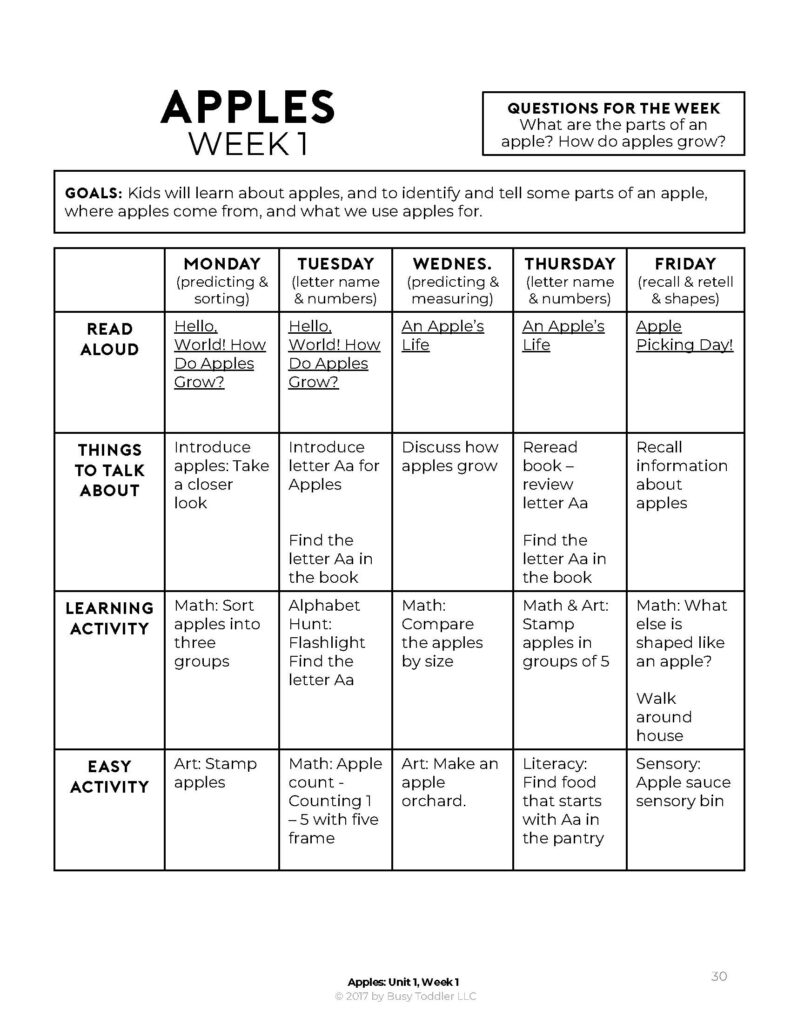
Daily Lesson Plan
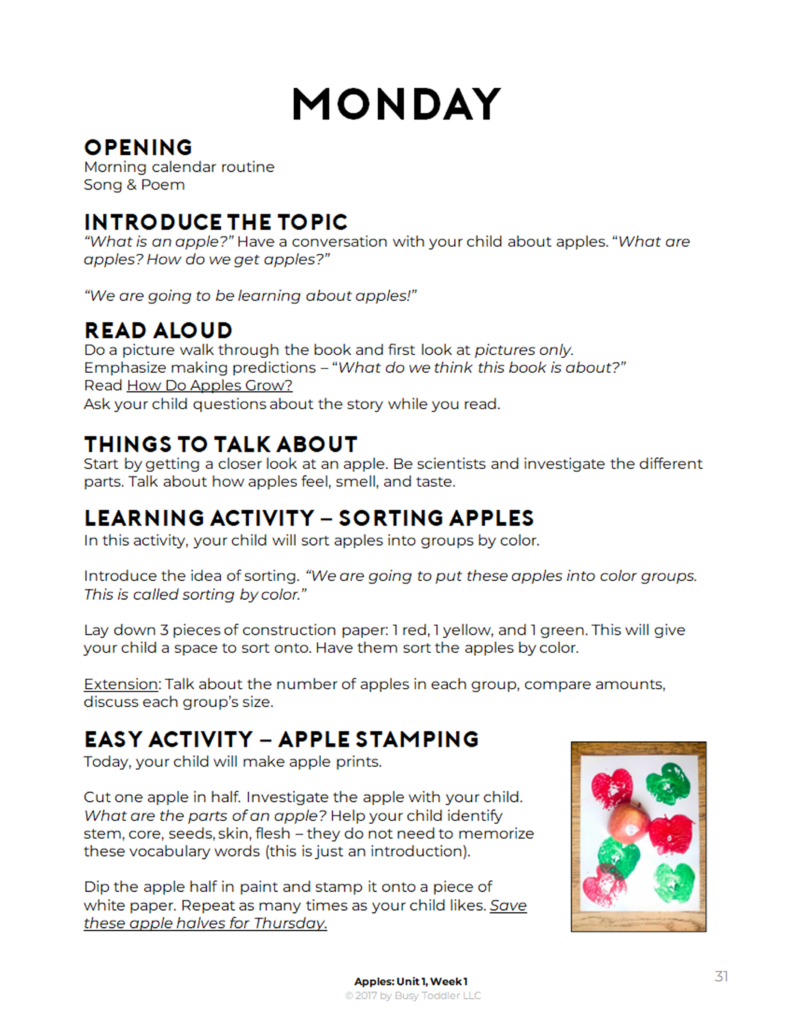
Once you purchase, the entire program is delivered instantly as a digital download. You’ll receive:
- A 300+ page eBook for each year, packed with step-by-step lessons
- A themed book list with suggested titles for every unit
- A simple supply list to streamline your prep
- A Start-Up Guide in Year 1 to walk you through everything you need to know before getting started
- An Introduction to Learning in Year 2 with added guidance, teaching tips, and kindergarten readiness insight
Playing Preschool was designed to remove the guesswork so you can focus on what matters most: enjoying these early years with your child.
What a Day with Playing Preschool Looks Like
Playing Preschool was built to be doable. A full day of learning takes just 45 minutes to an hour, making it a perfect fit for busy families.
Here’s how a typical day flows:
- Begin with a simple morning routine that includes calendar time, a song, and a short poem.
- Read a carefully selected book from the list of suggested titles that matches the week’s theme.
- Have a guided conversation on the unit’s theme using thoughtful discussion prompts.
- Do a hands-on learning activity together that focuses on an early math or language skill.
- Wrap up with an independent easy activity that reinforces the day’s concepts and encourages self-directed exploration.
It’s a daily rhythm that blends structure with play – giving you an easy, meaningful way to homeschool preschool at home.
Play-based learning that’s effective and child-focused.
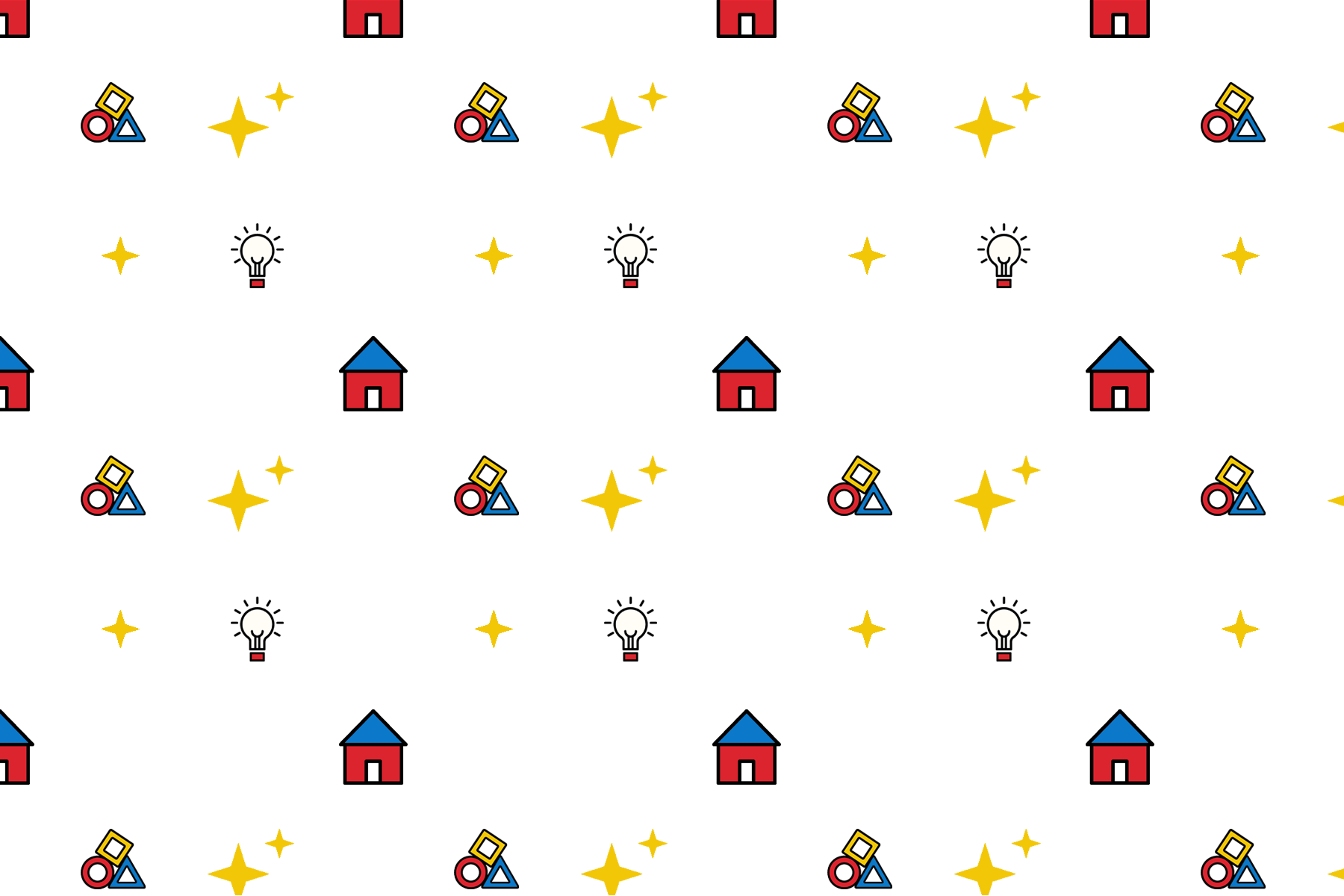
A Solid Start to Learning with Built-In Flexibility
Worried you won’t keep up with a daily routine? Not sure a structured program will fit your unpredictable schedule? You’re not alone…and Playing Preschool was written for you.
This homeschool preschool program was designed using my experience and expertise in early childhood, but was built for real families. I had a baby, toddler, and preschooler when I wrote this program so I knew how manageable and flexible it needed to be.
You don’t have to finish each day’s lesson in one sitting. Break it into short, manageable chunks, even five minutes here and there counts. And if you miss a day (or a week)? That’s okay, too. Playing Preschool doesn’t follow a strict calendar. It’s designed to pause when life happens and pick back up whenever you’re ready.
Whether you follow the five-day-a-week flow or stretch things to suit your own pace, this program adapts to your life, not the other way around.
Simple. Flexible. Doable. That’s how preschool at home should feel.
Step-by-Step Support from the Start
Starting something new can feel overwhelming, but Playing Preschool guides you every step of the way.
In Year 1, you’ll receive a comprehensive 20+ page Start-Up Guide that breaks down exactly how to teach the program. You’ll know what to do, why it matters, and how to get started, right from day one.
There’s no guessing. No scrambling to figure it out.
You’re not on your own.
And you don’t need teaching experience to make this work.
This program was built to support you, because when you feel confident, your child thrives.
Specific Guidance
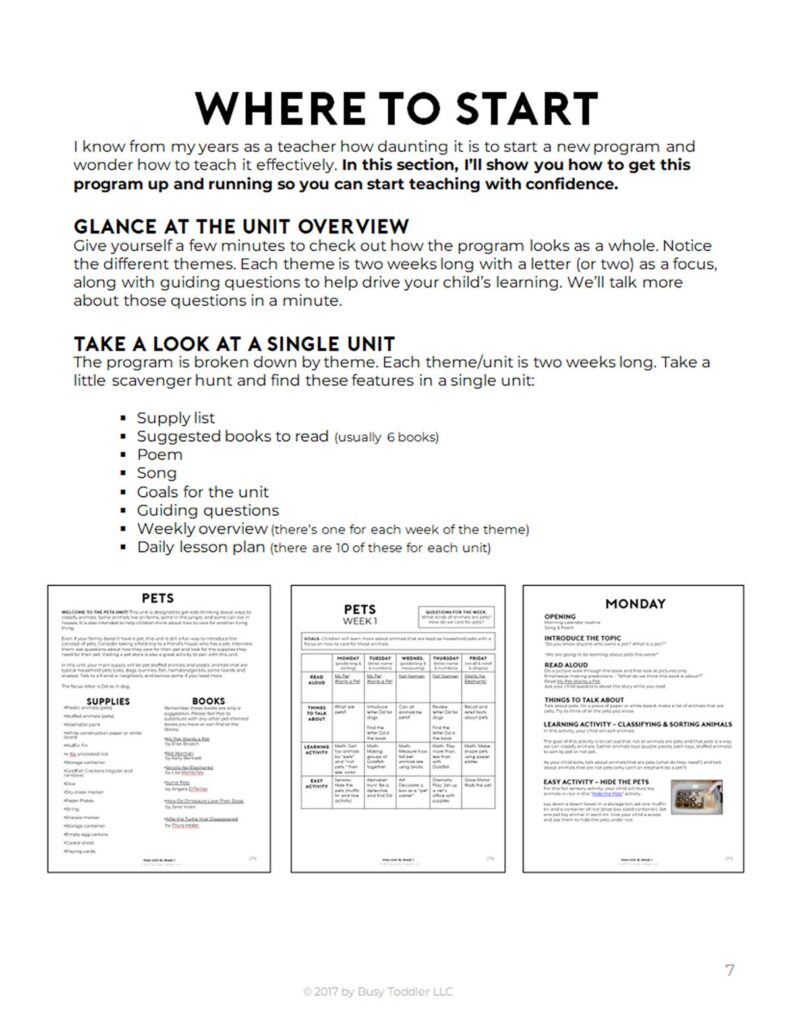
Detailed Support
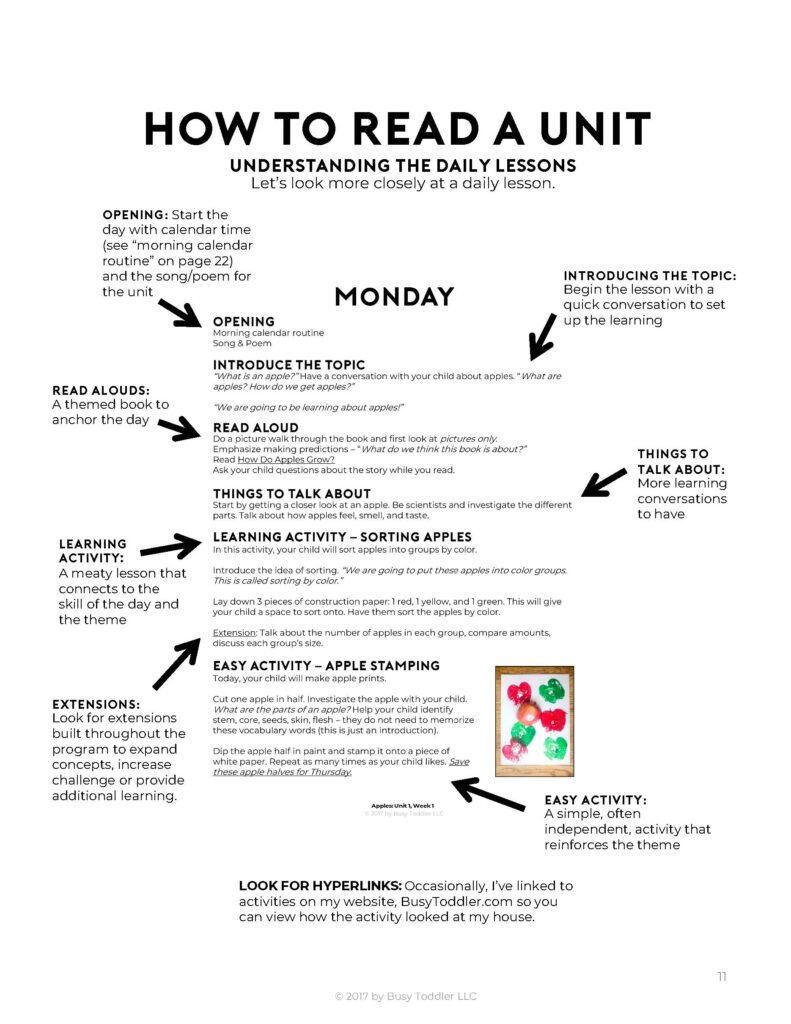
Clear Directions

What Your Child Will Learn
Playing Preschool makes teaching at home simple and meaningful with daily lessons full of hands-on, thoughtfully sequenced activities. Through playful exploration, children build foundational skills in literacy, math, science, and art, without worksheets or pressure.
Targeted Skills for Knowledge Development

Alphabet Foundations
Instead of relying on rote memorization, Playing Preschool nurtures a deep connection to letters through phonemic awareness, playful exploration, and meaningful repetition. Children begin to see letters as powerful tools.

Comprehension Skills
From predicting outcomes to answering questions and categorizing information, Playing Preschool helps kids grow their comprehension skills, laying the groundwork for strong reading and critical thinking later on.

Number Sense
More than just reciting numbers, kids develop a flexible understanding of quantity, subitizing (seeing amounts at a glance), joining and comparing numbers, and using numbers to describe the world around them.

Everyday Math
Beyond basic counting, the program covers early math concepts like measuring, sorting, creating patterns, graphing, and shape recognition – all through hands-on activities that make math feel natural and fun.

Recall & Retell
Recalling details and retelling events in order is an essential skill across subjects. This curriculum strengthens sequencing and storytelling through repeated opportunities to talk, process, and revisit what they’ve learned.

Life Skills
Learning through play means learning how to do real things, like scooping, pouring, measuring, cutting, gluing, and more. These fine motor and life skills are woven into the curriculum every week in meaningful and connected ways.
Engaging Play-based Learning & Simple Activities

Unit Themes for Playing Preschool



A Note on Year 2 & the Intentional Flow of Playing Preschool
Year 2 of Playing Preschool was carefully designed to build on the skills and confidence developed in Year 1. Children will continue to grow their abilities in sequencing events, classifying information, using ten-frames, measuring with non-standard tools, and making predictions in stories.
Because the second year relies on the foundation laid in Year 1, it’s important to complete Year 1 before starting Year 2. This intentional progression ensures your child’s success and makes learning feel natural and connected.
Why Playing Preschool Works
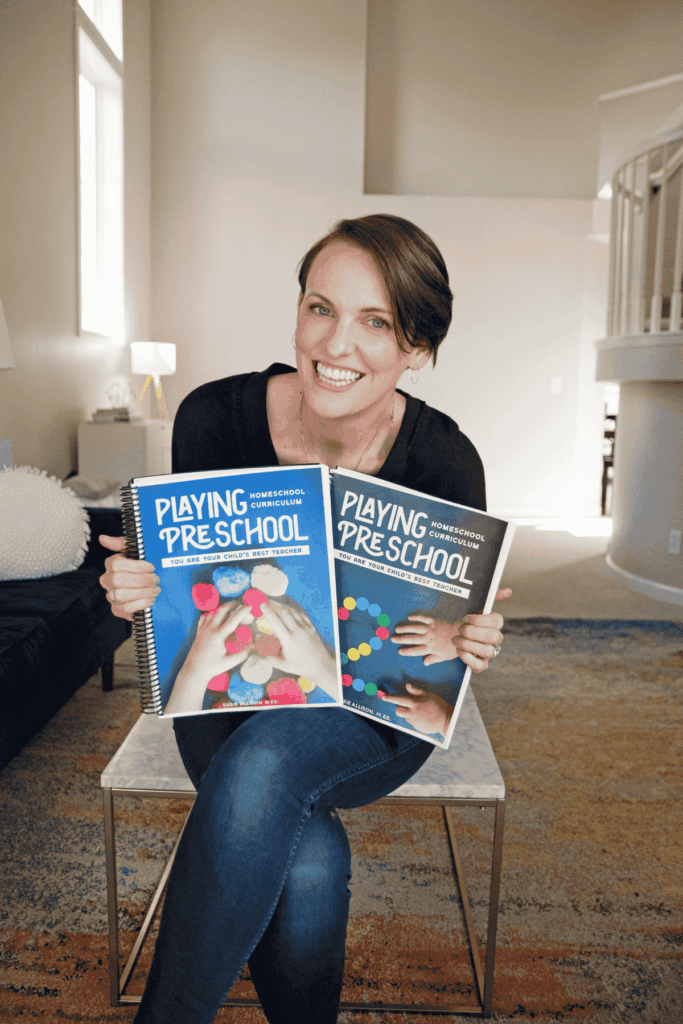
There’s a reason this program fits so seamlessly into homes around the world: it was designed with both research and real life in mind.
With a Master’s in Early Childhood Education and years of experience teaching in classrooms and raising my own kids, I created Playing Preschool to bridge the gap between what educators know works in education and what actually works for families at home.
That blend of evidence-based practice and lived experience is what makes this program so effective, and why countless families have found joy, confidence, and success using it.
Here’s a closer look at what makes Playing Preschool such a rewarding way to do preschool at home.
My Approach to Early Education
Education should light up a child’s life, not weigh it down. At its best, learning is both deeply personal and beautifully collaborative. It’s not something done to children – it’s something they actively participate in, building knowledge and understanding over time.
At the heart of Playing Preschool is a deep respect for children. Young children are capable of thoughtful reasoning, creative problem solving, and meaningful reflection – their thoughts and voices matter.
Playing Preschool embraces this philosophy. It treats children as capable partners in learning, inviting them to explore new ideas, share their thinking, and build foundational knowledge through daily connection and play with their caregiver. This is learning done with children, not teaching at them.
How Playing Preschool Teaches
Many preschool programs rely on scripted questions and one-word answers, leaving little room for creativity, critical thinking, or real conversation. These “closed-question” approaches often limit a child’s ability to explore, reason, and express original ideas.
Playing Preschool takes a different path.
This program uses open-ended prompts to invite curiosity, discussion, and deeper thinking. Instead of looking for one “right” answer, children are encouraged to share their observations, explain their thinking, and make connections in their own way.
Playing Preschool values where your child is developmentally and challenges them to grow – with respect, support, and room to think big.
It’s a program that celebrates children as individuals and gives them the tools to truly thrive.
Frequently Asked Questions about Playing Preschool
That depends. If your child’s needs are being met through a daycare or other preschool setting, then you probably don’t need an additional homeschool preschool program. Enjoy your time together in the evenings and weekends. Let them play. Read to them. Have conversations. But, if this is really on your heart, you’re struggling with a routine during non-working hours then this may be a good fit. I encourage you to try Unit 1 for free and see if it works before purchasing.
I do not. The cheapest way for me to offer this to families, and make it accessible around the world, is to keep the program as an eBook. You’ll receive the files via email. You are absolutely permitted to print one copy of Playing Preschool – I recommend using the Watson Family Press and their “print on demand” option for Playing Preschool.
First, I have an entire FAQ page dedicated to Playing Preschool. Second, email me at: susie@busytoddler.com. Please! I’d love to help you with any questions you may have.
Nope – Playing Preschool is a secular homeschool curriculum. It is easily flexible and adaptable to meet all families needs and values.
Playing Preschool does not follow a calendar, season, religion, or hemisphere. This is a secular preschool program that you can begin whenever your child is ready – whether that is in the fall, after the new year, or even in the middle of April.
Many families start Playing Preschool at the beginning of a traditional school year. Many families begin in January after the new year. Many families wait until spring for kindergarten readiness.
In Playing Preschool Years 1 & 2, we move beyond memorization.
We want kids to understand letters as a building block and tool for reading, to see letters in the world around them, and to form a knowledge base for when they are ready to read. We want our kids to truly know and understand letters.
There is a large emphasis in both Year 1 and Year 2 on building phonemic awareness, the ability to hear, manipulate, and identify sounds, which is a critical skill that directly impacts a child’s future reading success.
Alphabet knowledge continues to grow and develop in children throughout early elementary school. The process of “learning letters” cannot stop in preschool.
There’s more to numbers than counting, and number sense skills develop throughout a child’s life (high school algebra is still number sense!).
Numeracy is about understanding value, joining numbers together, comparing numbers, and recognizing numbers in various arrangements.
We dig deep with numbers in Playing Preschool. Throughout the program, children will use numbers, create with them, explore their purpose, and expand their understanding of how numbers interact in our world.
This is more than how high a child can count because math is more than just numbers: Playing Preschool lessons focus on measurement, capacity, graphing, and geometry as well.
The units in Playing Preschool are sequenced, with each building in complexity as the program unfolds. These aren’t random activities set at a random point in time.
Playing Preschool follows a clear line of progression: Skills build and grow, just as your child’s knowledge level builds and grows.
This is a unique feature of Playing Preschool not found in other homeschool preschool options. The lessons grow with your child and need to stay in the sequence they were written into the program.
For example, in Year 1, Unit 1, math activities focus on numbers 1-5. By Unit 19, activities focus on numbers 1-12 and how to join groups of objects together. This is all part of the thoughtfully designed scope and sequence of Playing Preschool. Unit 19 activities are a lot more challenging than Unit 1 activities – and they should be.





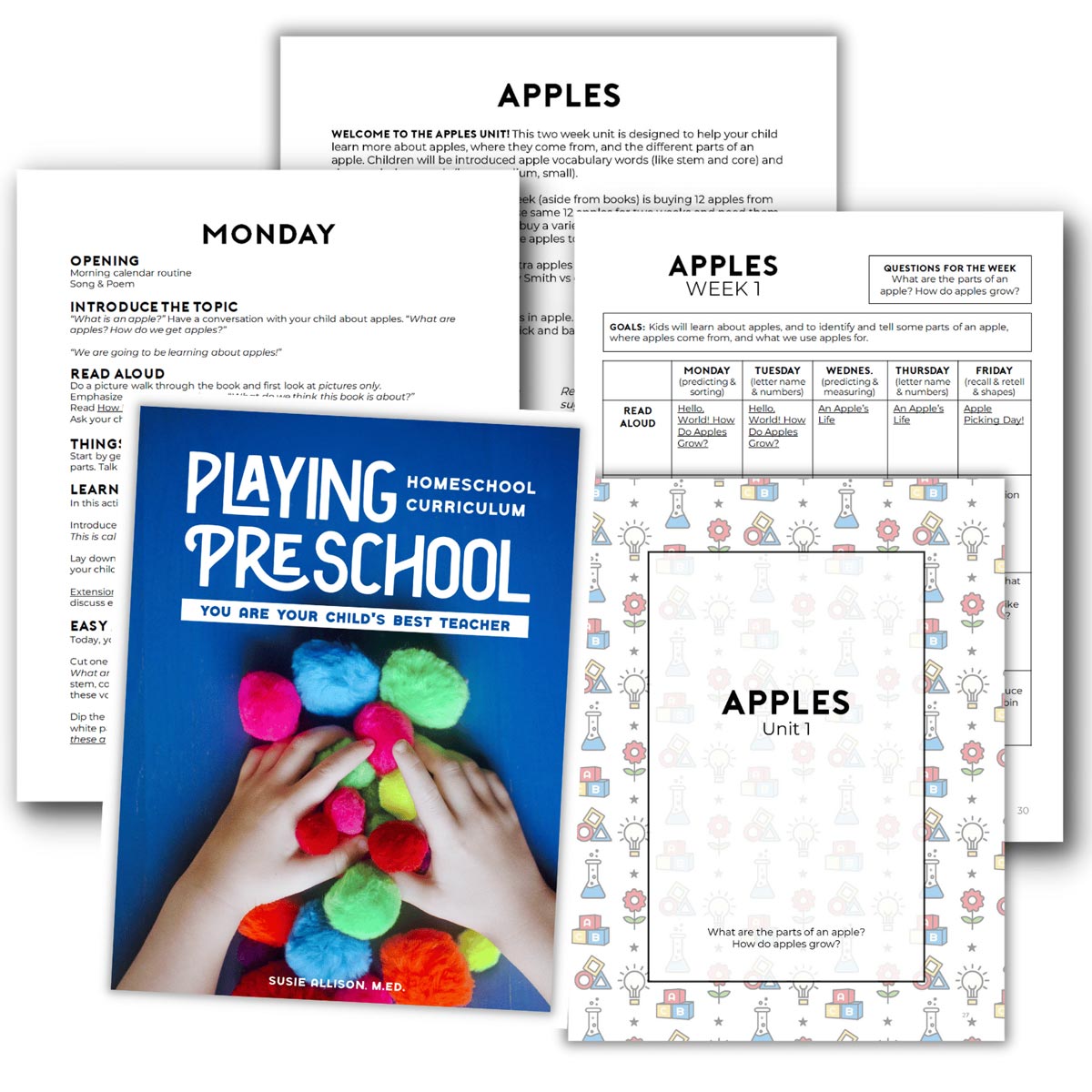
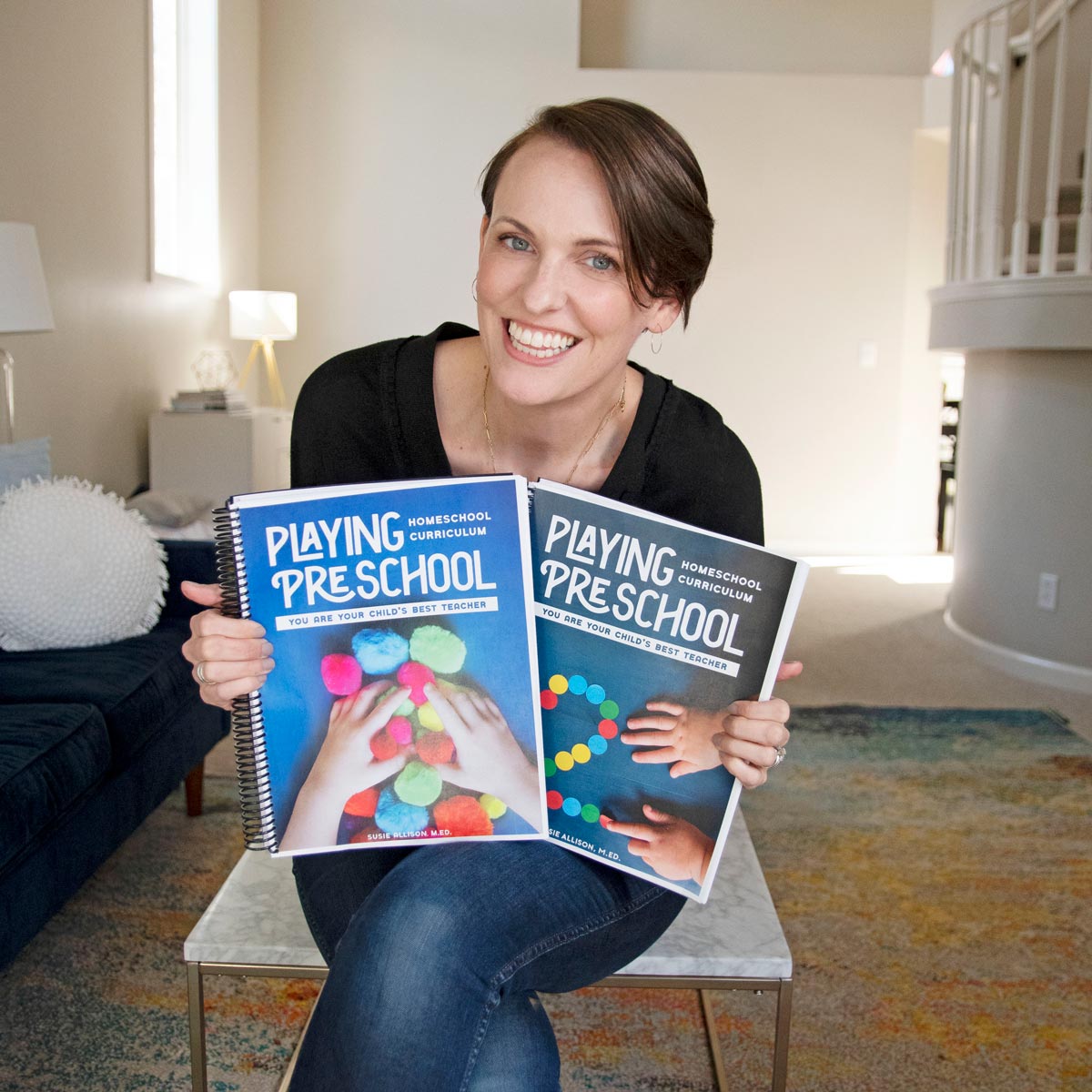

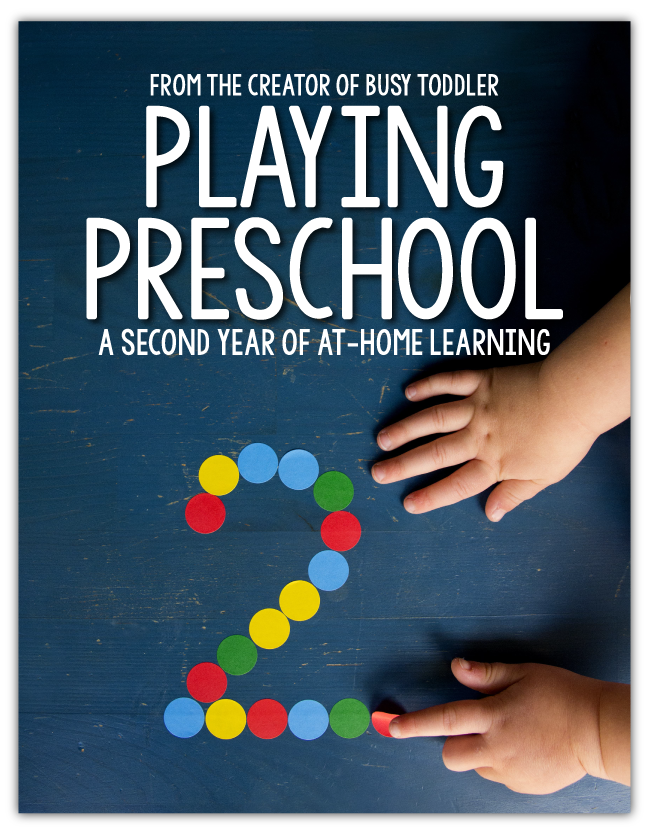
 Subscribe to my free newsletter and I’ll send you “35 Easy Toddler Activities to Break Up the Day!”
Subscribe to my free newsletter and I’ll send you “35 Easy Toddler Activities to Break Up the Day!”

Marivel says
Does this include activities for only toddlers and up? Or does it also include for Tabies and Babies?
Susie says
Hi Marivel, This is a comprehensive daily homeschool preschool program for ages 2.5-5. It does not include stand alone activities or ones for babies and tabies. Best! -Susie
Sharyti Williams says
We have loved using this curriculum for our kiddos! It’s such a great way to learn and play. My son’s always say they’re favorite part of the day is preschool and often ask why we’re not doing it on Sunday and Saturday. (Mom needs a break sometimes lol). It’s so great how easy it is to set up each days lesson and thanks to youtube we can find all the books on the list that might not be at our library.
We’ve just started looking at curriculum for homeschooling our Kindergarten to carry on the love of learning through play that playing preschool has nourished in our sons. Susie, do you have any recommendations for kindergarten curriculum?
Danielle says
My youngest daughter went through both years of Playing Preschool and loved the experience. My daughters are natively bilingual in Spanish so I translated both years so that our nanny could lead it and teach in spanish. They both had a fantastic time doing the activities and my daughter’s development was amazing. I would give the book lists to the librarian and see what they could help me find in Spanish or alternatives that fit with the theme. in all 2 years of themes there were only 2 that we didn’t love – I think teddy bears and fairytales. ALL the rest are so fun and the creativity behind the activities is impressive.
Once we were finished there was a real void of content for us…I missed how easy Playing Preschool made it for me to fill my daughter’s days with fun and enriching experiences. The library helped me get the books, I translated, amazon delivered the materials and our nanny delivered the experience.
The results were that my youngest started to will herself to read based on her knowledge of letter sounds at 3 years old, (despite my best efforts to stop her so she can focus on play.) She continues to push herself on HER OWN, she loves a challenge and I attribute that to her bring challenged via play and fun for her first “school”-like experience with Playing Preschool.